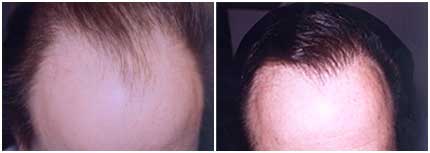Hair Loss Cycle
Written by Dr. Griffin
About Hair Loss
Hair loss is a medical condition where the patient experiences normal to advanced loss of hair anywhere on the body. Dr. Griffin mainly treats patients who want to regain lost hair on the scalp. In today’s society, hair loss can present a variety of problems, both psychological and physiological for the patient. Hair has come to represent a sense of youth and a holistic body image, while hair loss is typically associated with aging. Additionally, hair serves as a buffer to the damaging rays of the sun. Luckily, treating hair loss is now more effective than ever before. A hair loss consultation by Dr. Griffin will lead to the correct diagnosis and treatment of your problem.
Human Hair Loss and Growth Cycle
Each hair follicle’s growth is divided into three main stages – anagen ( active growth phase, lasting years), catagen (transitional degradation phase, lasting weeks), and telogen (resting phase in which the hair sheds and which lasts several months). In everyday instances of hair loss, a normal amount of hair shedding – whether in the shower or through routine hair combing – is not considered problematic and typically averages about 100 hairs per day, representing normal resting hair shedding. However, when hair loss accelerates and the patient experiences excessive or irregular amounts of hair loss, this can be cause for concern and consultation with a specialist is recommended.
Real Patient Before & After Photos
Causes of Hair Loss
In general, the main causes of hair loss include (but are not limited to) genetics, aging, hormonal imbalances, drug use, and systemic disease such as thyroid disease. Hair loss is most commonly found in the form of male or female pattern baldness, which is the process of healthy hair undergoing progressive miniaturization because of an ever-shortening active growth phase. As hair follicles convert from terminal hair – typically characterized as thick and healthy looking – into vellus hair – more commonly seen as fine, thin and easily breakable – patients begin to have varying degrees of thinning. The rate at which a patient can experience such hair loss is dependent on genetics which determines how hormones affect the hair follicle, although other factors such as stress may trigger or accelerate pattern hair loss.
Signs of Hair Loss
Hair loss in men typically manifests itself in the form of early to late-onset thinning. This condition can follow several patterns but typically begins as bitemporal recession, thinning in the crown area, and eventual progression to baldness on the top of the head. Meanwhile, in women, hair loss is typically defined by gradual thinning of hair with a widening of the part line and thinning on the top of the head without progression to total baldness in most cases. It is important for Dr. Griffin to correctly diagnose the cause of your hair loss, as subsequent treatment is dependent on each given patient’s specific hair condition.
Real Patient Before & After Photos
Hair Loss Prevalence
Approximately half of the United States’ population, both men and women, experience some form of hair loss, whether mild to severe. Alopecia areata is an example of an inflammatory condition defined by random patches of baldness throughout the scalp which affects men and women of all ages and can begin as early as the onset of puberty. This condition, which affects nearly 2% of the population, can disappear and return requiring ongoing treatment. Temporary hair shedding is also a common side effect of childbirth in new mothers and additionally can result from the prolonged use of certain medications. There are multiple causes of hair loss, requiring a consultation with a specialist to determine the cause and proper treatment.



